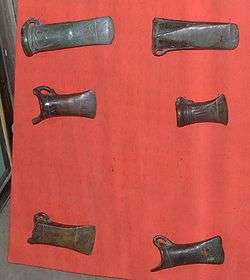Celt (tool)
In archaeology, a celt /ˈsɛlt/ is a long, thin, prehistoric, stone or bronze tool similar to an adze, a hoe or axe-like tool.


Etymology
The term "celt" may have come about from a possible copyist's error in many medieval manuscript copies of Job 19:24 in the Latin Vulgate Bible, which became enshrined in the authoritative Sixto-Clementine printed edition of 1592; this version has the word "celte" whereas the Codex Amiatinus, for example, has "certe" ("surely"). The Hebrew has לעד at this point, which means "forever". According to the Oxford English Dictionary it is not sure which reading is the original. Some are prepared to consider the existence of a real Latin word.[1][2]
A "celt" was thus wrongly assumed to be a type of ancient chisel. Early eighteenth century antiquarians, such as Lorenz Beger, then adopted the word for the stone and bronze tools they were finding at prehistoric sites; the OED suggests that the imaginary etymological connection with the Celts may have assisted its passage into common use.
A shoe-last celt was a polished stone tool used during the early European Neolithic for felling trees and woodworking.
See also
- Celt (toy)
- Palstave
References
- Laistner, M. L. W. (1 January 1925). "Floscvli Philoxenei [Flosculi Philoxenei]". The Classical Quarterly. 19 (3/4): 192–195. doi:10.1017/S0009838800015846. JSTOR 636281.
- ""Match 2" here". Archived from the original on 2011-07-17.
External links
- . Encyclopædia Britannica (11th ed.). 1911.